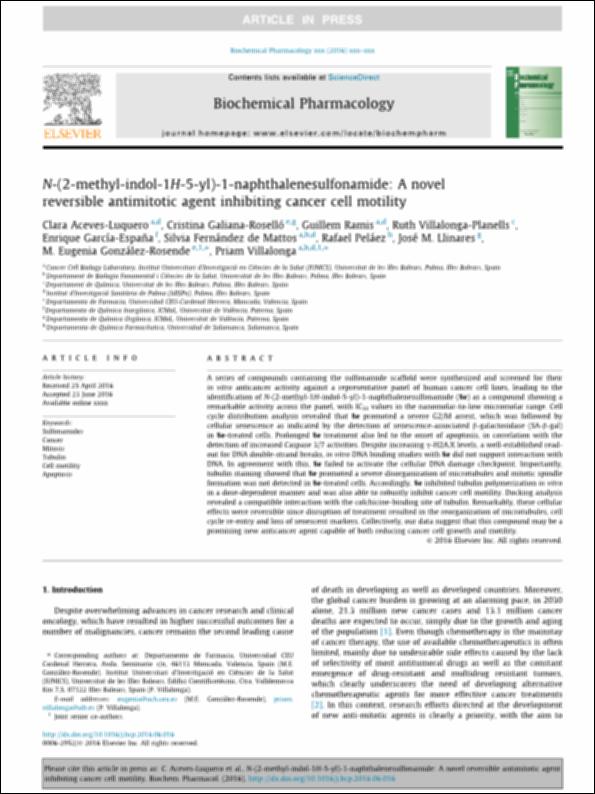Please use this identifier to cite or link to this item:
http://hdl.handle.net/10637/10593N-(2-methyl-indol-1H-5-yl)-1-naphthalenesulfonamide : a novel reversible antimitotic agent inhibiting cancer cell motility
| Title: | N-(2-methyl-indol-1H-5-yl)-1-naphthalenesulfonamide : a novel reversible antimitotic agent inhibiting cancer cell motility |
| Authors : | Aceves Luquero, Clara Galiana Roselló, Cristina Ramis, Guillem Villalonga Planells, Ruth García España, Enrique Fernández de Mattos, Silvia Peláez, Rafael Llinares, José M. González Rosende, María Eugenia Villalonga, Priam |
| Keywords: | Células cancerosas - Motilidad.; Cancer cells - Motility.; Mitosis.; Sulfamidas - Uso terapéutico.; Sulfonamides - Therapeutic use.; Apoptosis. |
| Publisher: | Elsevier |
| Citation: | Aceves-Luquero, C., Galiana-Roselló, C., Ramis, G., Villalonga-Planells, R., García-España, E., Fernández de Mattos, S. et al. (2016). N-(2-methyl-indol-1H-5-yl)-1-naphthalenesulfonamide : a novel reversible antimitotic agent inhibiting cancer cell motility. Biochemical Pharmacology, vol. 115, pp. 28-42. DOI: https://doi.org/10.1016/j.bcp.2016.06.016 |
| Abstract: | A series of compounds containing the sulfonamide scaffold were synthesized and screened for their in vitro anticancer activity against a representative panel of human cancer cell lines, leading to the identification of N-(2-methyl-1H-indol-5-yl)-1-naphthalenesulfonamide (8e) as a compound showing a remarkable activity across the panel, with IC50 values in the nanomolar-to-low micromolar range. Cell cycle distribution analysis revealed that 8e promoted a severe G2/M arrest, which was followed by cellular senescence as indicated by the detection of senescence-associated b-galactosidase (SA-b-gal) in 8e-treated cells. Prolonged 8e treatment also led to the onset of apoptosis, in correlation with the detection of increased Caspase 3/7 activities. Despite increasing c-H2A.X levels, a well-established readout for DNA double-strand breaks, in vitro DNA binding studies with 8e did not support interaction with DNA. In agreement with this, 8e failed to activate the cellular DNA damage checkpoint. Importantly, tubulin staining showed that 8e promoted a severe disorganization of microtubules and mitotic spindle formation was not detected in 8e-treated cells. Accordingly, 8e inhibited tubulin polymerization in vitro in a dose-dependent manner and was also able to robustly inhibit cancer cell motility. Docking analysis revealed a compatible interaction with the colchicine-binding site of tubulin. Remarkably, these cellular effects were reversible since disruption of treatment resulted in the reorganization of microtubules, cell cycle re-entry and loss of senescent markers. Collectively, our data suggest that this compound may be a promising new anticancer agent capable of both reducing cancer cell growth and motility. |
| Description: | Este es el post-print que se ha publicado de forma definitiva en: https://www.sciencedirect.com/science/article/abs/pii/S0006295216301423 |
| URI: | http://hdl.handle.net/10637/10593 |
| Rights : | http://creativecommons.org/licenses/by-nc-nd/4.0/deed.es |
| ISSN: | 0006-2952 1873-2968 (Electrónico) |
| Issue Date: | 25-Sep-2016 |
| Center : | Universidad Cardenal Herrera-CEU |
| Appears in Collections: | Dpto. Farmacia |
Items in DSpace are protected by copyright, with all rights reserved, unless otherwise indicated.


